Advertisement
Preparation info
- Makes about 30 dumplings, enough to serve
10–15
as an hors d’oeuvre . - Difficulty
Medium
Appears in
Published 1982
These light yet meaty mouthfuls are to south China what pot stickers and jyao-dz are to north China—the standard way of pairing meat with pasta in a fun-to-eat miniature dumpling. Shao-mai means literally “to bake and to sell,” but why steamed dumplings should be called “baked” is beyond my researches. Regardless, these little dumplings with their fluted edges and slightly peppery pork filling are better to eat than to ponder.
- Shao-mai</


